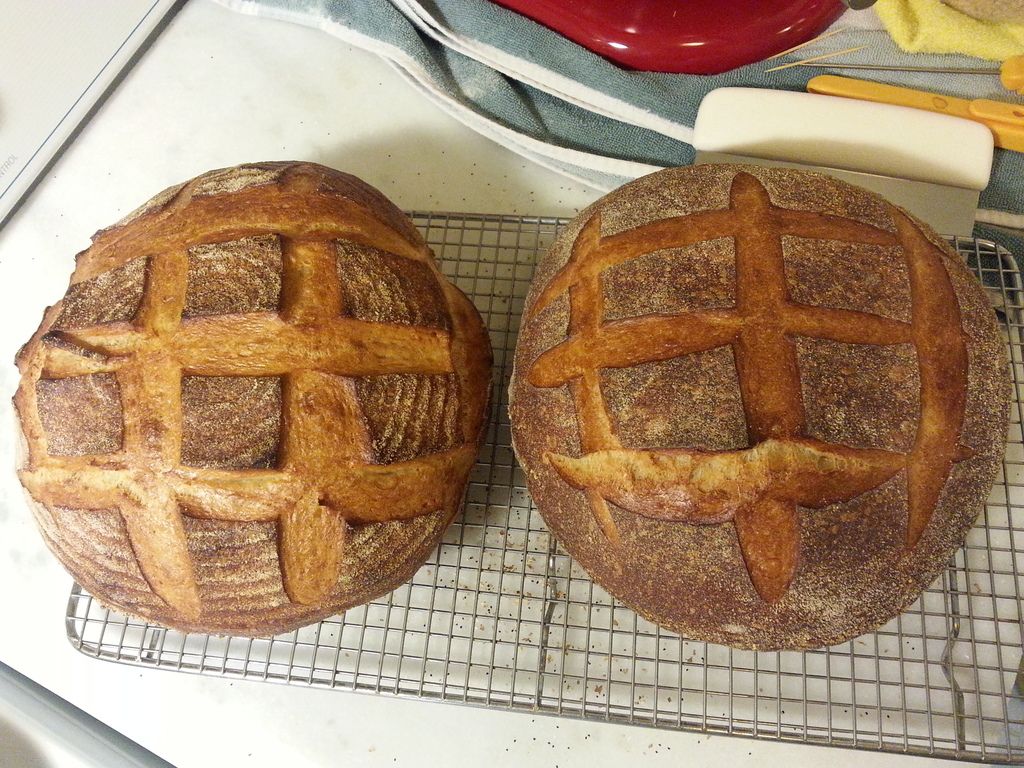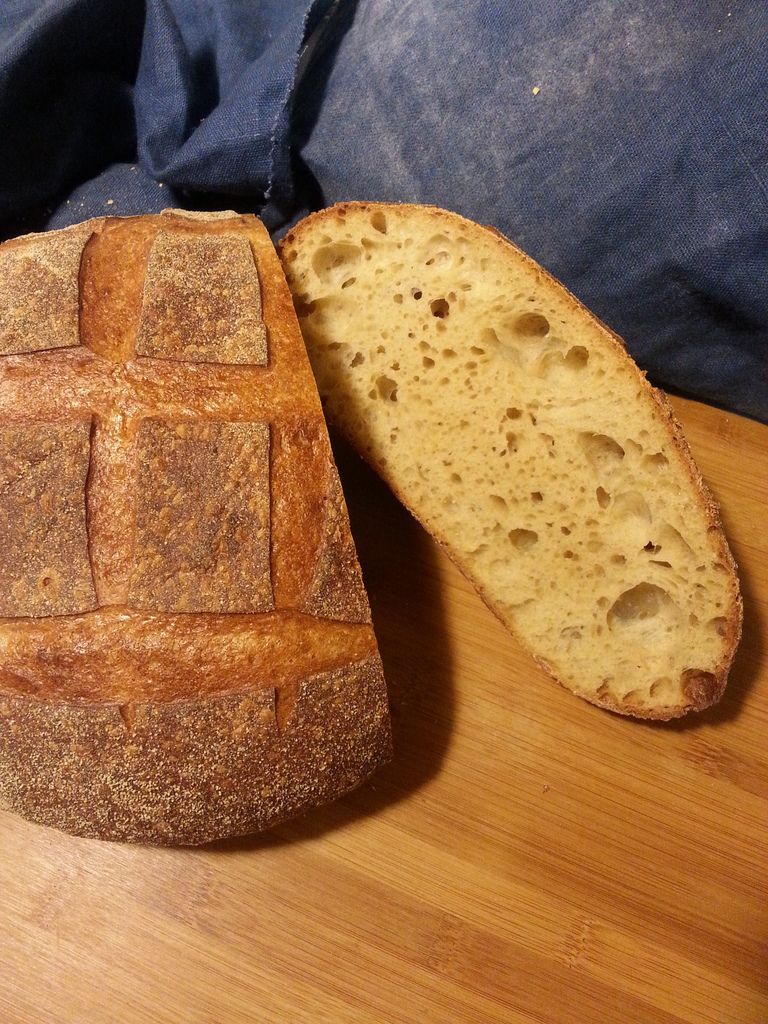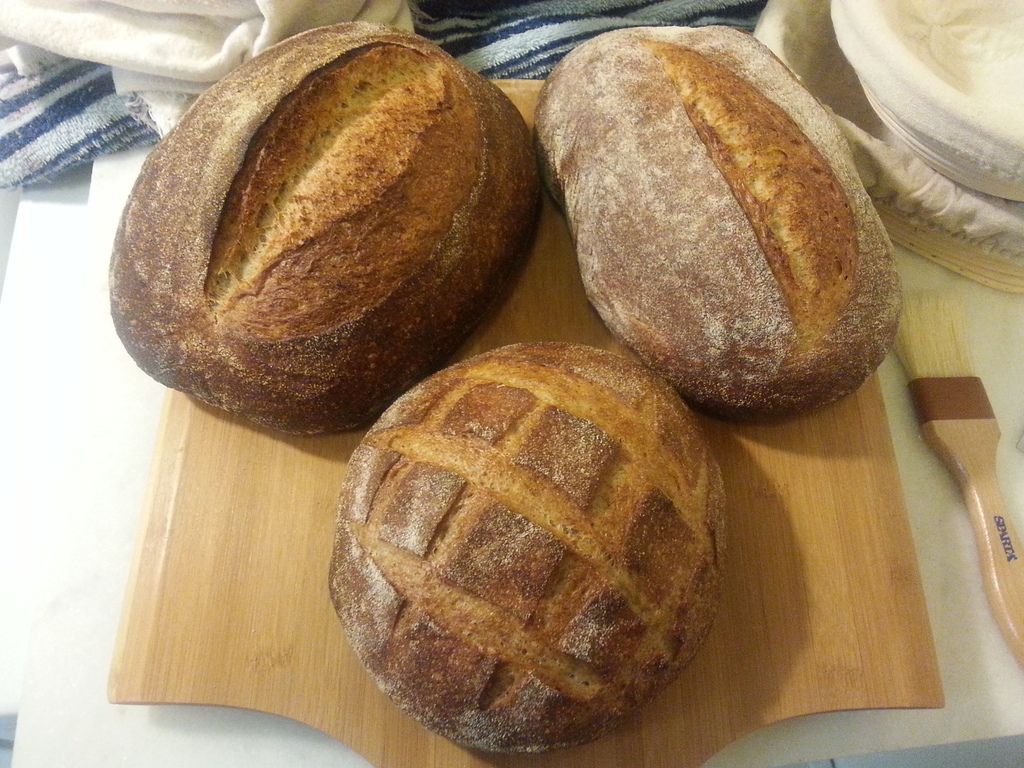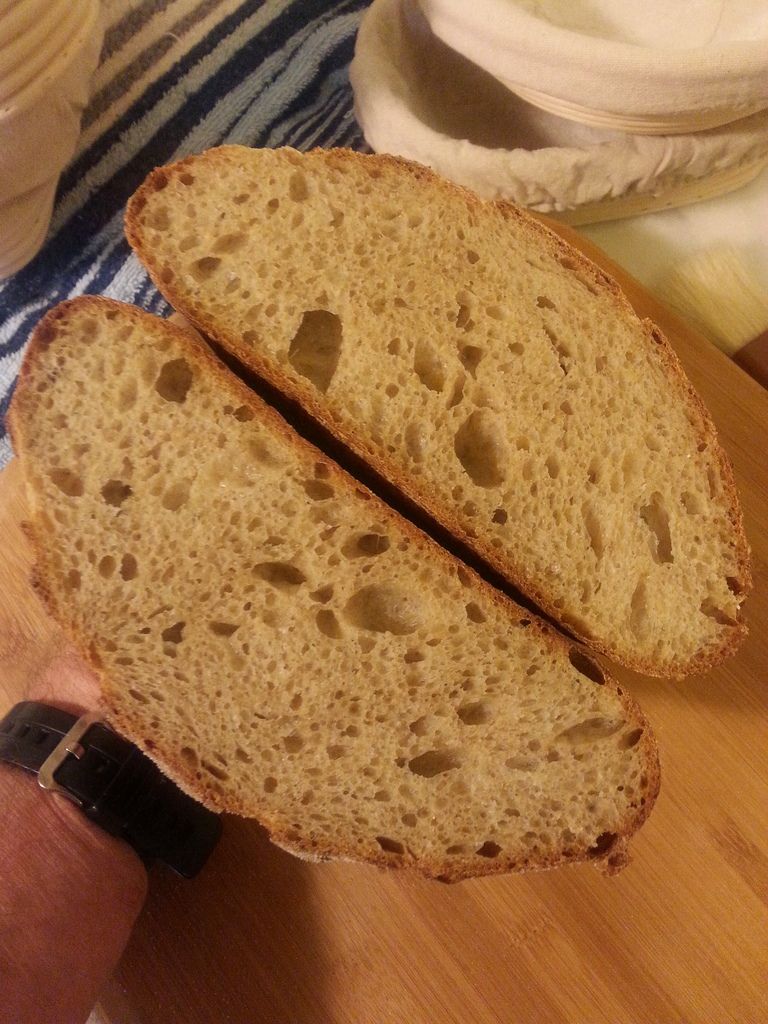Hello folks!
While I understand there are ways to make SD more sour (lower hydration starter, extended bulk or proof, others?) I'm looking for a more sour SD recipe. Today I tried the Norwich More SD and while it is quite delicious, it doesn't quite hit the sour I'm looking for. Any base recipes that are more sour to start? Would a SF SD recipe be more sour? I believe the Norwich more sour is based on a Hamelman recipe and I have Bread, just looking for something more along those lines. Edit to add that I used a rye starter and then white/wheat flour to build.
This site has been so awesome including providing links to other sites where I found the Norwich recipes. My bread is constantly improving, though shaping and scoring are still my biggest weaknesses.
Thanks!
Norwich SD


Norwich More Sour SD:


MORE TANG
http://brodandtaylor.com/make-sourdough-more-or-less-sour-part-2/
STEP ONE: Starter Build
10g starter
25g water
40g unbleached white flour
10g whole rye
Form the dough, place in container and leave to mature. Use about an hour after it has peaked. Ok to leave overnight for this first build, about 12 hours. Start the night before.
STEP TWO: Levain Build
30g starter from step one
75g water
125g unbleached white flour
25g whole rye
Form the dough, place in container (you’re going to need a bigger container and it needs room for quite a lot of expansion) and leave to mature. Use an hour after it has peaked. This will take quicker about 6 hours give or take. We want a really mature levain. It’ll be ready by late afternoon, early evening.
STEP THREE: RECIPE
All of the levain
241g unbleached bread flour
66g whole wheat flour
243g water
8g salt
METHOD:
1. Autolyse the flour and water for 30 minutes.
2. Sprinkle the salt over the dough and add the levain. You might want to break the levain up to make it easier to incorporate. Wet your hand then squeeze and fold the dough till fully incorporated. Give the dough a knead for a few minutes. The scooping method works well here from the video on www.breadwerx.com but however you wish. Bring it to medium gluten formation.
3. Give the dough a stretch and fold 3x at 20 minutes apart. I did the pinch and fold method. Then cover the bowl and bulk ferment till tripled. Mine took 2.5 hours from when the levain was added.
4. Pre-shape and bench rest till the dough visibly relaxes. About 20-30 minutes.
5. Shape into prepared banneton and refrigerate till the next morning.
6. Bake straight from the fridge in a pre-heated oven.
Thank you very much Lechem, this will be my next attempt. Guessing the high amount of levain and the fact that it is being matured fully will aid in the sour? Well give it a go and report back.
Bread has been delicious, I've just not found my ideal taste as of yet;-)
I found this on that website so please have a read about the science behind it.
The starter build I've given is how they advise on keeping your starter from which you build your leaven. In the recipe I've included it as two steps if you're converting from a more regular 100% hydration starter. I now keep mine at 50% hydration with a touch of whole rye as in step one: starter build.
They give a recipe and timing advice of when to use the starter and I built up the recipe around this. Apart from the ingredients and when to use the rest I've incorporated my own method. Feel free to experiment your own way. They didn't even advise overnight in the fridge I just added that in on top of everything else. Nor how much salt.
Yes using a lower hydration starter and leaven then using when really mature does help.
I look forward to your results.
They certainly look delicious!
This is a very popular method on this forum.
http://www.thefreshloaf.com/node/40918/no-muss-no-fuss-starter
Thanks for the reminder Filomatic! I've read about it and shied away from doing it only because I've been enjoying the upkeep on my starters--I feed them once a week whether I use them or not and it seems to work well. I really missed the part about it being a very low hydration mother which should give me the right mix of beasties I'm trying to achieve. Since I have been enjoying maintaining my current 3 (rye, wheat, spelt) I may as well add a fourth especially since it will be even less upkeep than the others while adding something to help with the sour goal...win/win :-)
It does seem to be very popular among SD bakers here and I should know by now that if there is something this popular around these parts there is likely a good reason. I'll make a new starter this evening to add to the mix.
Adding rye helps. Also retarding the dough helps. The other thing would be to use a firm stater. Converting is not the same thing. Just maintain it for a week or so and it should be good to go (you might see more changes if you keep at it for 2 weeks though).
Edit to add: Also, I find that using less starter helps because it has to bulk ferment longer, but a lot depends on the starter with this method. Usually I just manipulate the dough (mostly with retarding) to get more sour.
Thanks, I plan on building according to the directions posted...using my rye starter as the initial seed...also plan on using a heat pad because I noticed the original 'recipe' called for working at @80f and my kitchen stays @70f year round.
Also, that's a nice tip about using less starter and allowing for a longer bulk...I have noticed that a long final proof also aids but I'm still not hitting it so maybe a bit longer bulk and a shorter proof?
The starter build is actually advice on how to keep your starter. However I did include it as a build as hopefully if left to fully mature and then the Levain is left to fully mature, so we have two steps, hopefully it should coax out some more flavour. But really the starter "build" is actually advice on how to keep your starter for more sour. Still in order to go down that route it'll have to start off as a conversion and overtime the flavour profile should change. When I tried this the first time it did make a flavoursome bread. Going from strength to strength now.
is using whole grains. The bran acts as buffer allowing LAB to continue to reproduce and make more acid at lower pH's than they normally could.
The 2nd most important thing is high temperatures, 90-92 F for counter work like starter and levain builds, gluten development and final proofing. Number 3 is cold temperatures for a very long time for starters - weeks, as long as possible for levains 2-3 days and bulk ferments - 24 hours.
Number 4 is hydration. Less hydration with low temperatures promoted acetic acid production over longer times.
A SD culture can have 10 to 1 LAB to yeast ratio - less sour or 100 to 1 LAB to yeast ratios - sour. The above promotes LAB reproduction rates while restricting yeast reproduction rates which leads to a starter, levain and dough that has higher LAB to yeast ratios which means each can produce more acid than those that have less LAB in them.
Temperature and hydration also can promote the two kinds of acid that LAB produce, Lactic acid - the normal acid that provides sour and acetic acid the 'tang' in SD. A balance in both is what makes for good SD bread in my book as does a more sour taste in general.
But this is completely personal and most people by far prefer bread that is not sour or less sour when sourdough is in the mix. Luckily, we know the science well enough today to make what ever kind of sourdough bread we personally like just by manipulating all of the above at the right time, for the right length of time. But that is not all.
It is just science and the kind of wee beasties you have in your culture. Some wee beasties can produce as much CO2 as yeast and some can be prompted to produce CO2 and ethanol and little acid just like yeast do. Some produce more acid than others some don't produce much acetic acid and others a lot of it. So, you can change your sour and tang profile by using a different culture without changing anything else in the method.
Happy sour baking
Thanks for the detailed response...I had just replied when my post got lost because the computer had logged me out and now there is no trace:-(
As to your point about using whole grains, I most often do though likely in too low an amount (20-30%) to be of much use so I'll try upping these a bit. Early results with flatter loaves led me back to lower percentages, perhaps I just need to figure out how to better work with them.
On the next couple of points, I have not tried either...my kitchen stays ~70f so that is the temperature I normally work...I broke out the heating pad today to try making the NMNF starter and will continue to incorporate it's use in my bread. I have been doing a rather long slow/cold proof but have not tried a longer bulk and a shorter/warmer final proof. I'll be trying the longer storage of the starter once I get it made up--guessing that about 3 weeks should get it to an appropriate place to start using it?
I have made a few attempts at lower hydration while doing a 1-2-3 SD and remember the bread coming out delicious but at the time I wasn't paying close enough attention to the specific amount of sour and I believe I did a rather quick run at all stages when I made these so they likely weren't that sour either.
I feel like I've picked up so much in a few months of SD baking but still have so much to learn...makes this all so much fun. Off to develop the beasties, thanks again so much for your help!
If your starter is at all active it contains live yeast and lactobacilus bacteria. The yeast, at the right temperature, will make your dough rise. The lactobacillus will make your dough get sour. The longer you allow your dough to sit at 40 degree (that is to say, in your fridge) the more sour it will get without over-rising as at fridge temperature the yeast virtually goes dormant. When I want a more sour flavor I let the dough go through it's first rise to almost double its original volume then, covered with plastic wrap or some such, and place it in the fridge, sometimes for as long as a couple of days. I then take it out, form the loaves, maybe let them warm up to room temperature or not, and bake them. The longer in the fridge, the more sour the flavor, regardless of how much starter is used or what kind of flour it was made from.
Great looking loaves, by the way. No reason that dough could not rest in the fridge a day or two before being baked.
Thank you Rich, something I never considered was allowing the fresh dough (at first rise) to rest for that long...mainly because I had no idea it would hold up. As to my starters, I currently have 3 and believe them all to have pretty healthy mix of beasties (even if not the right mix) because they rise the loaves well when I do bake. I plan on trying an extended bulk (also recommended above but at a much lower time frame) and will plan on doing a 'super' extended bulk sometime soon...it is really helpful to learn the limits of what the dough will accept and unfortunately I've been a bit timid about taking anything this far along. I'm rather excited to see what comes out of the fridge after a few days--so no final proof necessary, just shape and bake?
Thanks again.
much you use in the overall formula but when and where you use it. For a 800 g bread at 75% hydration that has 10% whole rye and 10% whole wheat, very much a white SD bread but one with extra flavor that will still be very open, there will be 457 g of flour and 343 g of water in it.
The whole grains in the mix would only total 92 g half WW and half rye. If you use 10 g of a 16 week retarded NMNF starter that was built at 92 F it will have 6 g of rye in it and 4 g of water but we will ignore that for our calculations. The 92 g of whole grains will have about 12 g of bran in it. That would be the first flour feeding for the levain which would be twice the flour in the 10 g of NMNF starter,. Feeding two would be 24 g of the high extraction remainder of the whole grains and feeding 3 would 48 g of remaining high extraction flour. That means you used 84 g of the whole grains in the levain ....leaving 8 g for the dough flour, You would use equal amounts of water in the levain. The levain would be 10g of starter, 84 g of whole grains and 84 g of water making it 178 g total of which 90 g od flour and 88 g is water. So the levain would be about 20% pre-fermented flour at 98% hydration.
This levain would be built over 3 builds of about 3 hours each at 88-92 F and then retarded for 48 hours. Things happen pretty fast at that temperature during build.
Now you have 8 g of remaining high extraction flour for the dough flour and 359 g of some kind of white flour AP or bread flour plus 255 g of dough water. You would autolyse this at 92 F with the 2% salt sprinkled on top for an hour. Then you would add the now warmed up retarded levain, mix, do gluten development and bulk ferment on the counter at 92 F - remembering things go very fast. The you shape, place in a basket and retard the dough until it proofs 90% ....... 12-24 hours depending on how cold your fridge is and bake it cold right out of the fridge.
This will give you a bread that is as sour as your starter can produce.
The important thing to remember is that you want to promote LAB over yeast at every stage. People always seem to concentrate on the yeast in the SD culture but they need to concentrate on the LAB instead. Less yeast means things take longer to proof and be ready for the oven and the more time a highly concentrated LAB bread has, as opposed to yest concentrated bread, the more sour it will be because the more LAB have more time to make acid and the high temperature favors LAB to yeast at least 10 to 1.
Some combination of these techniques ill give you the kind of sour bread you like. If making a whole grain bread, the powerful taste of the grains themselves will mask some of the sour flavor, so making it as sour as possible is usually OK. For a whole rye bread the more acid the better since acid keeps the amylase enzymes in check so that they don't mess up the crumb of rye breads. But, for a whitish bread, less sour that that is needed to get a really sour bread.
SD bread making is all relative to and the variables of time, temperature, flour and hydration all can be manipulated to get what ever you want out of it in the end.
Happy baking
Thanks DB! It's not so much that I always want an extremely sour bread, but I've somehow managed to figure out how to get a nice (for me) loaf of SD with almost no sour. My control test of using rye starter vs wheat starter in otherwise similar loaves was a real eye opener so I'm beginning to understand some of the what and why, now adding in some when will be very helpful.
I follow your 'recipe' and once I get some good nmnf starter ready I'll give the full Monty a go to see just how sour I can get. The idea of the long 'autolyse' with the higher bran content also makes perfect sense. I can tell already that my problem will definitely be in monitoring the faster rate
I'm making a batch of (nmnf) starter now and the second addition has more than doubled in a bit under 2 hours...I'm not so used to working with a heat pad and the temperature had risen close to 100f, I'm going to go with the third addition now and monitor closely for 25% before stowing it in the refrigerator with a date marked. I'm also very interested in using this starter to make Mini-oven's 100% rye (her ideal rye ratio bread) which I really like.
Finding the upper limits of sour and how to control the individual variables is what I'm trying to accomplish. I appreciate all the help getting me going in the right direction.
to control it to make what ever you want is the fun part of SD bread making for me. It took me awhile to figure out the heating pad and getting enough towel between the heat and the levain/ starter to keep the temperature at 88-90 F. Having a prtoofer is really the way to go but that is another $150 bread thing. Next thing yoy now you are making bread fior $300 a loaf instead of a buck:-)
Thanks for the advice with the towel, I only wish I had read it before I made my starter:-) I wound up using a towel over the starter and heating pad so the temperature was a bit higher than suggested. I don't believe it was high enough to do damage but not sure if I wound up in the sweet spot for the beasties I'm trying to grow. Next time the towels will go under the starter but for now I'm sticking with the batch I made. I don't plan on using it for a couple of weeks so it can start to develop the sour taste I'm after.
I don't mind skipping/rigging a proofer as I really like the idea of the inexpensive loaf. Now to just make that dollar loaf as predictable as possible. I too am looking to get to the place where I can envision it and then pull it off...though I realize I've a way to go to get there.
are getting the sour bread you're after (and I can't think of any of them not working for you)
...go find out the alkalinity of your water! High alkalinity will prevent the pH from dropping in the sourdough starter and the dough.
That is why adding baking soda to dough tends to reduce sour. Sourdough has low pH readings. Baking soda raises the alkalinity or raises pH readings.
Now to think about the opposite, perhaps adding a Tablespoon of lemon juice or vinegar might be your ticket to more "sour."
Didn't even think about the home pH but happen to have a calibrated meter and measures right ~6.5 which I'm guessing is fine. As to the 'additions'. I'm trying to avoid going there and am guessing that by the time I work my way through the help already received that I should have something plenty sour for my tastes:-)